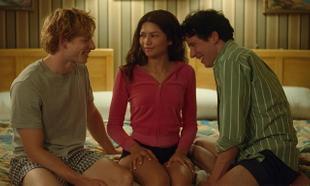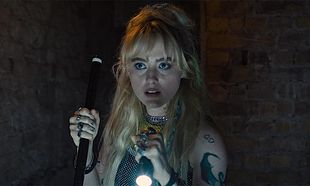It shouldn't work as well as it should. This documentary from Sophie Fiennes (The Pervert’s Guide To Cinema/Ideology) may disappoint some as it's no historical recap of the model and singer's career to date: shot over ten years, Grace Jones: Bloodlight & Bami (Jamaican slang for the red light in a studio and a local bread) is a loose fly-on-the-wall expose of the veteran as Jones attempts to put an album together (a reggae-infused hip-hop/electronica hybrid) while flitting between New York, Paris, Tokyo and Moscow for concerts.
The message is clear. Grace Jones is an absolute legend and if you don’t know this then there’s no sympathy for you. Because there's no context supplied. No clips of her receiving awards in her heyday. No stories behind those wonderful album covers. No videos. No Conan The Destroyer. Instead the viewer is treated to snippets here and there of Jones as she juggles work, touring and family. Jones seems totally comfortable with the camera (she and Fiennes don’t interact) and lets it all hang out. Standout scenes include her cajoling Sly (of Sly & Robbie) to fulfil his promise of being in studio when she booked it, and letting the producer of a French TV channel that she’s not happy with the staging: "I look like a lesbian madam in my whorehouse."
While the grainy lo-fi resolution of the private scenes backstage, in cabs, or in hotel rooms don’t visually arrest the eye, Fiennes makes up for it by letting the camera roll on Jones’ onstage antics. With their inventive backdrops and her outlandish costume changes, the concert scenes resemble a mashup of Stop Making Sense and Bjork’s weird dress sense. Jones prowls the stage like a tigress, majestic and frightening. At one point she sings along to a hit while simultaneously breaking the hoola-hoop record – no mean feat. Later, a wonderful three-way sequence sees Jones working on a tune in the studio, humming lyrics while cooking in the kitchen, and the final product live on stage.
And how young does Jones look at 69? As a family member points out over dinner (Jones moves back to Jamaica to record her new album) "everyone in the Jones family look younger as they get older." He's not wrong - sometimes, when she is silhouetted by the stage backdrop, it could be 1982.
Bloodlight & Bami would have benefited from little more digging into Jones' personal life, which, despite the journey back home and conversations with exes and her son, the viewer's knowledge of the art-pop mistress isn't as greatly improved as perhaps it should be.









































































